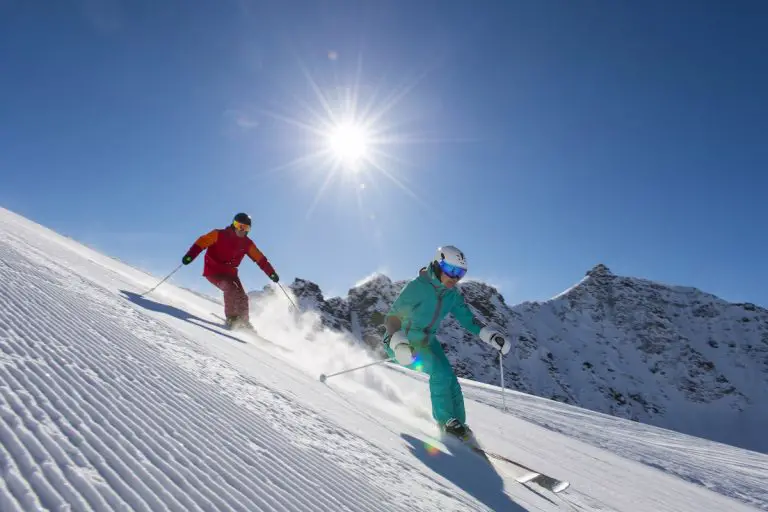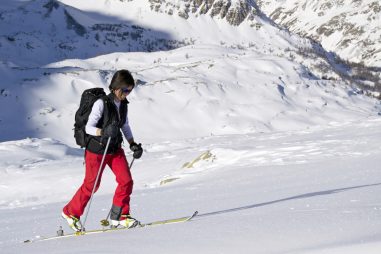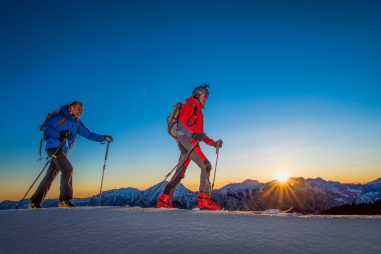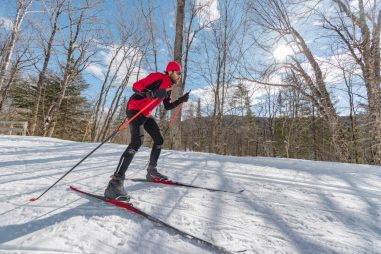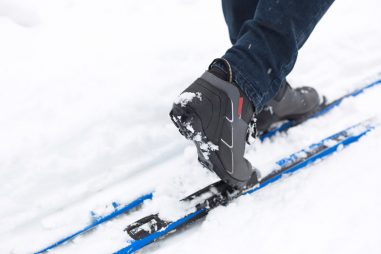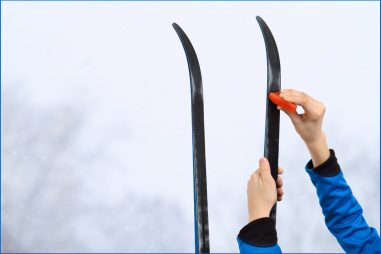While cross country and downhill skiing use skis and poles, the two sports are vastly unique. They have different techniques, equipment, and provide an experience that the other can’t replicate.
Which one is better for you? One discipline is harder than the other. Both have their appeal and are fun sports to engage in. Here’s a rundown of their similarities and differences to help you decide.
Is Cross Country Skiing Similar to Downhill?
Cross country and downhill skiing both use skis and poles. They’re both fun sports to engage in. And the biggest similarity is that you need to master controlling your speed on a downhill descent. This includes the various deceleration or braking techniques.
When it comes to learning, both require time and effort to be good at either discipline. But that’s where the similarities end.
How Is Cross Country Skiing Different From Downhill Skiing?
There are a lot of major differences between the two disciplines. Here’s a rundown of each:
- Skis: You use different skis for each discipline. That’s because you need to accelerate using your own power for cross country skiing. And technically, this requires a different set of skis versus skis made for downhill skiing.
- Movement and Technique: You just need gravity for downhill skiing. It’s a different story for cross country. Because you create your own acceleration, movements are starkly different.
- Terrain: In cross country skiing, you can ski on flat, uphill, and downhill tracks. You can even go off track and ski wherever the snow is thick enough. For downhill skiing, you’re limited to going downhill at a ski resort.
- Muscles Used: Cross country skiing requires you to engage all your major muscle groups in your upper and lower body, as well as your core. Such is not the case for downhill skiing.
Is Cross Country Skiing Safer Than Downhill?
Cross country skiing is safer than downhill skiing because you get to choose where to ski. If you’re a beginner and still trying to get better, you can cross country ski exclusively on flat terrain. Even if you fall, it won’t be as dangerous.
You can move on to uphill and downhill descents once you’re confident enough with your skills. And even so, cross country tracks have gentler slopes.
In downhill skiing, you’re more likely to suffer a serious injury if you fall because of the steeper slopes.
Is Cross Country Skiing Easier or Harder Than Downhill Skiing?
Given the nature of the two disciplines, cross country is generally easier than downhill skiing.
With cross country skiing, you can start learning on flat terrain before graduating to skiing uphill and downhill. This makes it accessible for skiers of all ages. That’s why even kids can learn cross country skiing.
However, cross country skiing’s techniques are more difficult to learn. It requires coordination, balance, and a lot more effort. It can be more tiring since you don’t have gravity to assist you. This aspect makes it harder than downhill skiing.
And when it comes to descents, it’s hard for both disciplines. Mastering speed control and stability are imperative for both. But for cross country skiing, you have the option to take on gentler slopes.
As opposed to downhill skiing, you descend resort slopes at high speeds. You need to learn edging, turning, and braking techniques. So for this aspect, downhill skiing is more challenging.
Cross Country Skis vs. Downhill Skis
Since these are two different disciplines, they require different skis. For cross country skiing, you need skis that allow you to execute the shuffling and gliding movements so you can accelerate on your own. You also need skis that will give you more balance as you move in different directions.
Meanwhile, downhill skis are specifically designed for fast descents. They’re also made for effective turning and edging. They’re also constructed to take on different kinds of snow.
How Do You Tell the Difference Between Downhill and Cross Country Skis?
The main difference between downhill and cross country skis is the binding. For cross country skis, only your boot’s front part is attached to the ski. With this heel-free set-up, you have more balance and stability for you to traverse various terrains. You can also walk with cross country skis.
On the other hand, your boots are completely attached to your skis for downhill skiing. This limits your mobility so you won’t be able to do what cross country skiers can. You can only go downhill but the advantage is that you can go at higher speeds.
Aside from function, the skis also differ in length and width.
Are Downhill Skis Wider Than Cross Country?
The skis used for downhill skiing are wider than cross country skis. They also differ in shape. Downhill skis get thinner in the middle, forming an hourglass shape.
And since there are different downhill ski types made for different snow conditions, their width will vary as well. Downhill skis are usually 3 to 5 inches (80mm to 120mm) wide.
Cross country skis are narrower and longer. This lets you slide and glide on the tracks with ease.
Can You Cross Country Ski With Downhill Skis?
It’s not possible to use downhill skis for cross country skiing. Downhill skis are designed for high-speed descent. They’re less stable and you’ll be challenged to find your balance if used for cross country skiing. Downhill skis are also designed for aggressive turning in mind, something that you don’t need for cross country skiing.
Also, because downhill skis completely connect your boot to the ski, you won’t be able to do the movements needed for cross country skiing. It’ll be impossible to move and generate your own speed as well as traverse flat or uphill terrain.
Can You Use Cross Country Skis for Downhill Skiing?
Cross country skiing also involves going downhill. So if it’s about going downhill, you can use cross country skis. Professional cross country skiing competitions have athletes going downhill at high speeds too.
But for downhill skiing, using cross country skis will be difficult. Cross country skis usually lack metal edges, making edging harder. As a result, you get less control when making aggressive turns. They’re also narrower which makes them unreliable and harder for you to balance.
Cross Country Ski Boots vs. Downhill Ski Boots
The main difference is how the boot connects to the ski. Cross country boots connect to the ski at the toe area only, leaving the heel detached. For downhill skis, the boot is completely attached to the ski.
They also have different functions. Cross country skis need to be flexible to make movements easier. It also allows you to traverse various terrains. On the other hand, downhill ski boots need to provide more stability and control. This makes them stiffer and bulkier.
Are Cross Country Ski Boots the Same as Downhill Ski Boots?
Cross country boots differ completely from downhill ski boots.
Cross country boots are often made from soft leather or a synthetic material. They’re much easier to fit and are more flexible. This flexibility is critical for you to move comfortably. This also makes them lighter than downhill ski boots.
Downhill ski boots are made of hard plastic and clip completely to the ski. They’re not flexible, which gives you more control when edging and turning. This also makes it impossible to ski uphill.
Can You Use Downhill Ski Boots for Cross Country Skiing?
It’s not possible to use downhill ski boots for cross country skiing. You need a heel-free system in cross country skiing, something that you won’t get from downhill ski boots. Plus, they’re bulkier, heavier, and not flexible. You won’t be able to use your cross country skis at all.
Why Cross Country Skiing Is Better Than Downhill
Downhill skiers may not agree, but cross country skiing is the better sport. Here are some reasons why:
Anyone Can Get Into It
No matter your age, as long as you’re in good health and have a decent fitness level, you can get into cross country skiing. It’s easier to learn and less intimidating than downhill’s steep and fast descents.
The technique is also easier to learn. With practice a few hours a day, you’ll be able to cross country ski in no time.
It’s a Full-Body Workout
If you’re looking for a physically challenging sport, cross country skiing is the way to go. It requires high cardiovascular and muscular endurance. You also work your body’s major muscle groups, making it a great full-body exercise.
Want to burn a lot of calories? With cross country skiing, you’ll burn around 700 calories in just an hour!
You Get to Explore the Countryside
In downhill skiing, you’re stuck at the ski resort. You can only ski in selected areas on the mountainside. But with cross country skiing, you can ski on track and off-track.
You’re free to explore the backcountry terrain and immerse yourself in the environment. And being in a peaceful environment benefits your mental health. It helps lower your stress levels and calms an anxious mind.
No Lines
One of the worst things about alpine skiing is waiting in line to ski or to ride the lift, especially during peak season. Or you can wake up extra early to get ahead.
You won’t be bothered by this with cross country skiing. Tracks are vast and you don’t need to wait your turn. Exploring the countryside gives you even more freedom to ski without worrying about other skiers.
You Can Ski at Your Own Pace
With cross country skiing, you can keep things relaxed. You’re not forced to go downhill at high speeds. Instead, you can ski at a leisurely pace on the terrain you desire.
You can also take a break whenever you want to and enjoy the scenery with friends and family.

